Basic Aztec Facts: Aztec Clothing
Your clothes were your ID card in the Aztec world. What you wore showed your job, your social rank, and even where you were from. It was all part of a strict system, with rules for everything from the fiber in your cloak to the style of your sandals, all tied to the Aztec social classes and the structure of Aztec society.
More Than Just Clothes
For the Aztecs (or Mexica), clothing was a language. Every piece of clothing, from a simple cloak to a fancy lip plug, told a story about you, your job, and your place in the world. It clearly announced a person's status, gender, and home town.
The Mexica clothing system mirrored the empire itself: complex, well-made, and full of rules and symbols. To figure this out, we look at three things.
First, we have codices, which are historical accounts from the 16th century, like the famous *Florentine Codex* and *Codex Mendoza*. Next, we have archaeology, which has uncovered rare bits of actual cloth from sacred sites like Tenochtitlan. Lastly, we have the work of modern historians who piece it all together.
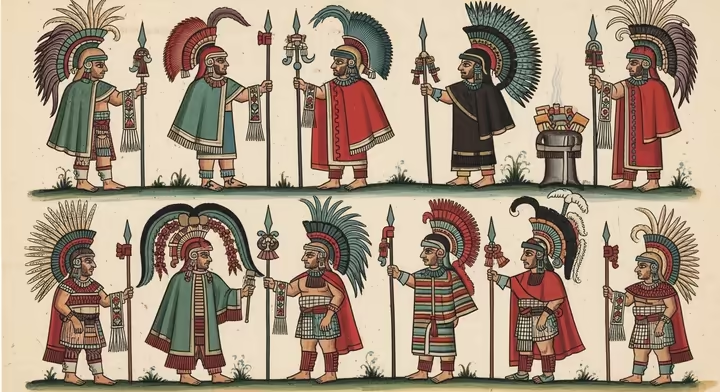
What It Was Made Of
The Aztec clothing system started with its raw materials. What your clothes were made of wasn't your choice, it was a legally enforced sign of your social standing.
Fibers of Status: Cotton for Nobles, Maguey for Commoners
Aztec textiles came from two main fibers: *ixtle* from the maguey cactus (a type of agave), and *ichcatl*, or cotton. This basic difference drew a sharp, legally enforced line between common people and the elite. Commoners, or *macehualli*, wore clothes made from coarse, sturdy *ixtle* fiber.
In contrast, cotton, or *ichcatl*, was a luxury material strictly for the nobility, the *pipiltin*. The law was so important that if a commoner was caught wearing cotton, the punishment could be death. Cotton was so prized it was also used as currency and as a key tribute item demanded from conquered lands.
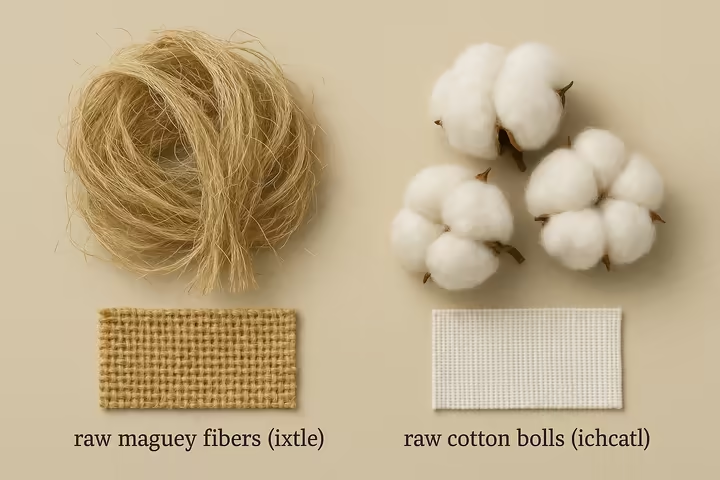
This strict separation of fibers was both a status symbol and the backbone of the empire's economy. By limiting who could use cotton, the state made it a valuable item they controlled. This control meant cotton textiles, especially specific cloaks called *quachtli*, could be used like money and as political gifts.
The Weaver's Touch: Mastery of the Backstrap Loom
The main tool for making textiles was the backstrap loom. It was simple, portable, and had no big frame. A weaver tied one end to a tree or post and the other to a strap around her back.
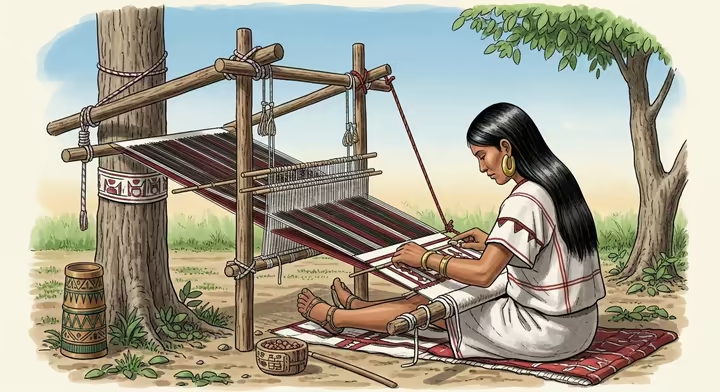
By leaning, she used her own body to control the thread tension, creating a personal connection with the fabric. This let weavers create long pieces of cloth, though the width was limited by their reach.
Weaving was considered the ultimate female skill. Baby girls were even given tiny weaving tools at birth, symbolizing their future roles. By age fourteen, most girls were expert weavers, which was a huge deal for the family and the empire's economy.
Since weaving happened at home, women played a direct role in the economy. The empire used this system to get its most important product, tribute textiles. This also helps explain why noblemen had multiple wives, more wives meant a bigger home textile workshop, producing more wealth.
Colors of an Empire: The Art and Symbolism of Dyes
The Aztecs lived in a colorful world, and their clothes showed it. Dyers used a rich array of colors from plants, animals, and minerals. Color was a way to communicate status and meaning.
The most prized dye was cochineal, called *nocheztli*, which made vibrant, long-lasting reds. It came from the crushed bodies of tiny female insects that live on nopal cacti.
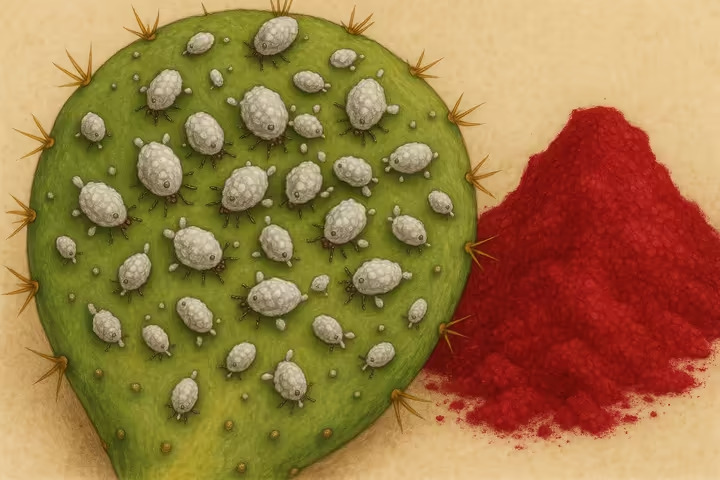
This "cactus blood" was so valuable it became a major tribute item. After the conquest, the Spanish valued it almost as much as gold and silver.
Other colors came from various sources too, indigo plants gave rich blues, while certain trees provided yellows. They were also experts at dye chemistry, changing a dye's acidity with lime juice to get different shades from a single pigment.
Woven Status: Clothing, Social Rank, and Strict Dress Codes
In Aztec society, clothing was the quickest way to know someone's social rank. A detailed system of dress laws was taken very seriously. These laws made sure that a person's rank was literally written on their body.
Everyday Attire: What Aztec Commoners Wore
The clothing of commoners, the *macehualtin*, was simple and practical. Men wore a *maxtlatl*, which was a loincloth. This was a long piece of fabric passed between the legs and tied at the waist.
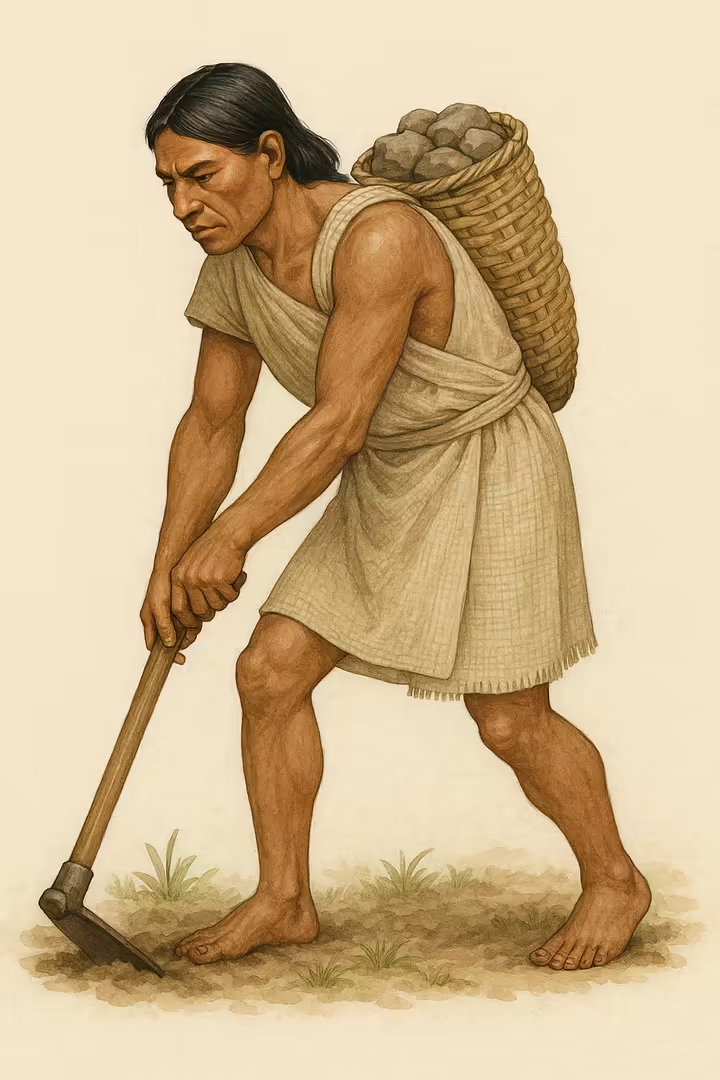
For more covering, they added a rectangular cloak called a *tilmatli*. Made from rough maguey fiber, a commoner's *tilmatli* was usually plain. By law, it couldn't hang below the knees, which clearly marked their lower status.
Commoner women wore two main items: the *cueitl*, a wraparound skirt, and the *huīpīlli*, a sleeveless tunic. These were also made from maguey or other plant fibers and were generally plain.
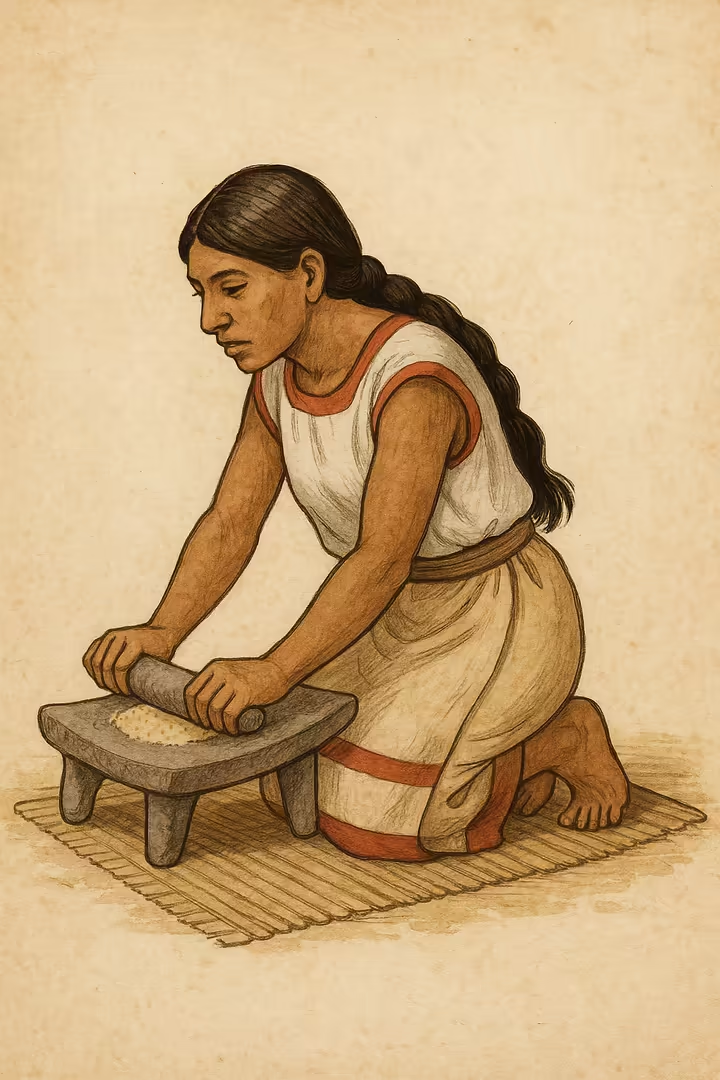
Clothing also marked life stages. Children usually wore nothing until age three. At thirteen, boys could finally wear the *maxtlatl*.
Dressing the Elite: Cotton, Colors, and Complexity
The wardrobe of the *pipiltin*, the nobles, was a world away. Their clothing shouted status through exclusive rights to luxurious materials, brilliant colors, and complex designs. They wore fine cotton garments, often dyed in stunning shades and decorated with embroidery and featherwork.
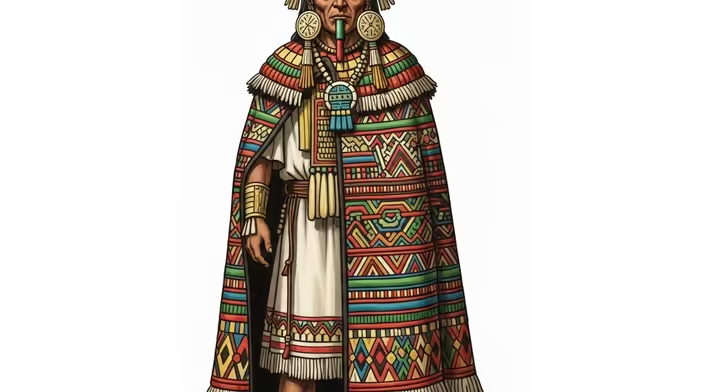
Even how a garment was worn was defined. A nobleman tied his *tilmatli* over his right shoulder. Only the emperor could wear his long, embroidered cloak tied at the front, a unique sign of supreme power.
Laws on Looks: Pre-Hispanic Sumptuary Rules and Enforcement
The differences in dress weren't just tradition, they were strict laws. Breaking these rules could lead to severe punishments, even death. Commoners couldn't wear cotton cloth, sandals, or precious adornments like shimmering feathers.
The long-distance merchants, or *pochteca*, are a great example. Though they could become very wealthy, they were commoners by birth. To avoid angering the nobles, they would sneak into the city at night with their rich goods and wear simple maguey fiber capes in public to show their lower status.
This system made society easy to "read." You knew immediately who had authority, who deserved respect, and who was a subordinate, simply by their clothes. The laws ensured the smooth operation of a deeply layered society.
Adornments of Distinction: Sandals, Labrets, and Earspools
Footwear was a major status symbol. Sandals, or *cactli*, were a privilege mostly for noblemen, high-ranking warriors, and royalty. Commoners typically went barefoot.
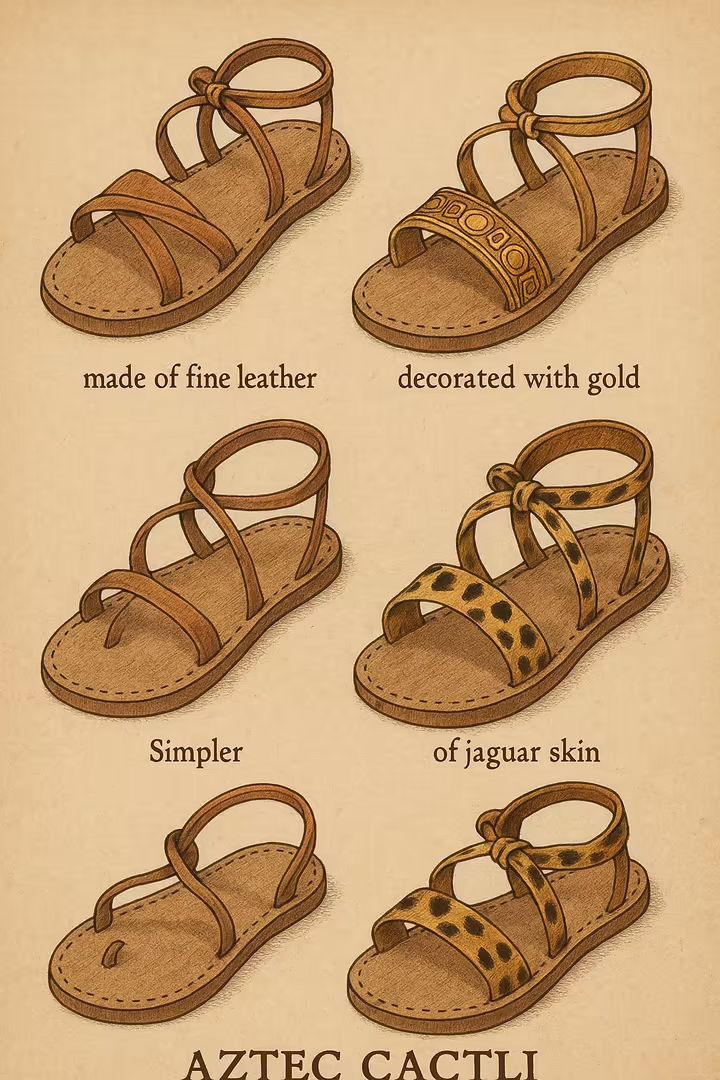
A key rule was that everyone, no matter their rank, had to be barefoot in sacred places like temples or before the emperor. This symbolized a leveling before divine and supreme power.
Facial adornments also showed rank. The *tentetl*, or labret, was a plug worn in the lower lip that signified high status and warrior skill. The labret's material clearly showed rank, gold and jade were for the top elite, while commoners were restricted to bone or wood.
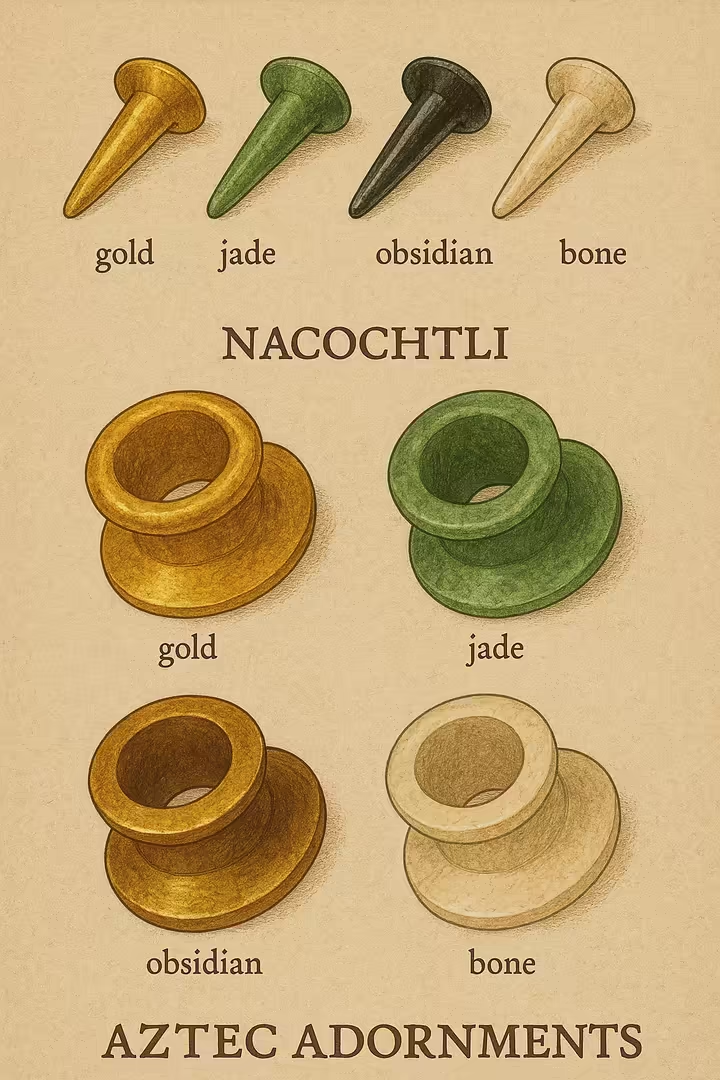
Similarly, earspools (*nacochtli*) communicated rank through their material. Gold and turquoise were the most prestigious. The body became a canvas for displaying earned status, especially for warriors, a permanent, public declaration of a man's bravery.
| Nahuatl Term | English/Description | Primary Material(s) | Associated Social Class/Rank |
|---|---|---|---|
| Maxtlatl | Loincloth | Maguey fiber, Cotton | All male classes; decoration varied by rank |
| Tilmatli | Rectangular cloak/cape | Maguey fiber (commoner), Cotton (noble) | All male classes; length, material, and knot style varied by rank |
| Xiuhtilmatli | "Turquoise cloak"; prestigious blue cape | Dyed cotton | High nobility, Rulers |
| Huīpīlli | Sleeveless blouse/tunic | Maguey fiber (commoner), Cotton (noble) | All female classes; decoration varied by rank |
| Cueitl | Wraparound skirt | Maguey fiber, Cotton | All female classes |
| Quechquemitl | Triangular poncho-like garment | Cotton, Feathers | Noblewomen; Goddess impersonators/priestesses |
| Cactli | Sandals | Agave fiber, Leather, Animal skin | Nobility, High-ranking warriors, Royalty |
| Tentetl (Labret) | Lip plug | Gold, Jade, Obsidian (elite); Wood, Bone (commoner) | High-status men, especially warriors |
| Nacochtli (Earspool) | Ear plug/spool | Gold, Turquoise (elite); Pottery, Wood, Obsidian (commoner) | All classes; material denoted status |
Power Threads: Special Attire for Ritual and Warfare
Beyond everyday wear, the Aztecs created spectacular outfits for warriors and priests. In battle and ceremonies, a costume was a transformative tool. It allowed people to take on the power of an animal or a god.
The Warrior's Wardrobe: Armor and Emblems of Elite Orders
Aztec military clothing was a complex system that showed rank and achievements. The base layer was the *ichcahuipilli*, or quilted cotton armor. This sleeveless jacket was about one to two fingers thick.
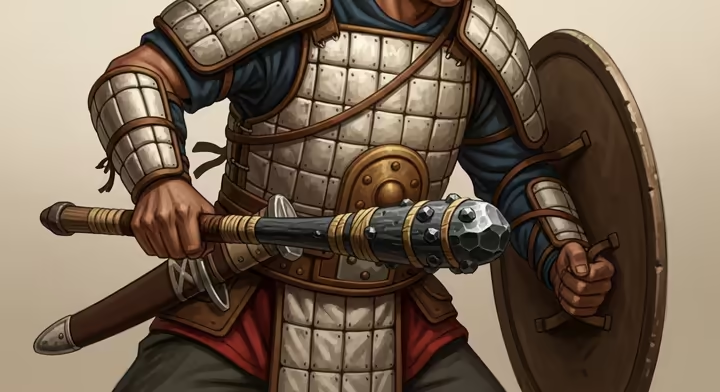
When soaked in brine, it became surprisingly good at stopping obsidian blades and absorbing impacts. Over this armor, high-ranking warriors wore the *tlahuiztli*, a stunning, full-body suit. These suits were covered in a mosaic of bright feathers or even jaguar skins.
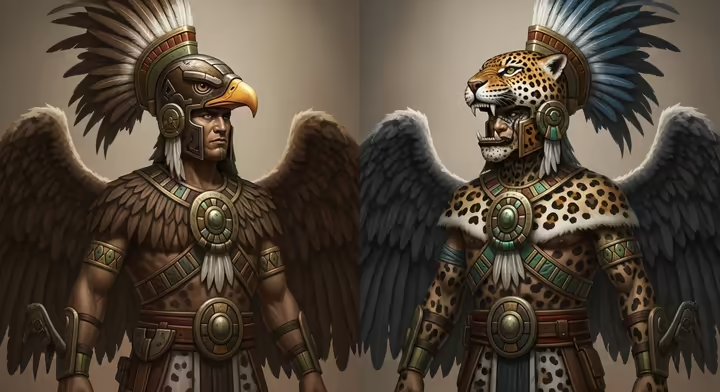
A warrior's rank was based on how many enemies they captured in battle. This system offered a way for commoners to move up in society. Capturing one enemy got you a flowered cloak, two earned you a red and black feather suit and a pointy hat, and four captives allowed you to wear the awesome jaguar suit.
The most prestigious warriors belonged to the elite Eagle and Jaguar societies. They wore full *tlahuiztli* of feathers or jaguar skin. Their wooden helmets represented the animal's head, with the warrior's face looking out from the creature's open jaws.
Divine Designs: Featherwork, Master Artisans, and Sacred Regalia
Of all Aztec crafts, featherwork was the most precious. Feathers were valued more than jade or gold, seen as divine expressions that brought the supernatural world to mortals.
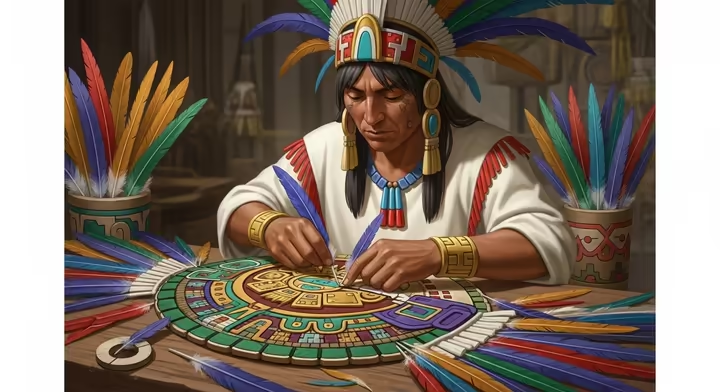
This sacred art was the exclusive craft of the *amanteca*, a special guild of featherworkers. These artisans painstakingly arranged thousands of tiny feathers to create shimmering mosaics.
The most sought-after feathers were the long, green tail plumes of the male Resplendent Quetzal. The most famous creation is the "Headdress of Moctezuma," made of nearly 500 quetzal plumes and thousands of other feathers and gold ornaments.
Sacred Vestments: Understanding Priestly Clothing
Priestly clothing was specialized to show their sacred roles. Priests were often shown carrying incense bags (*copalxiquipilli*) and tobacco gourds.
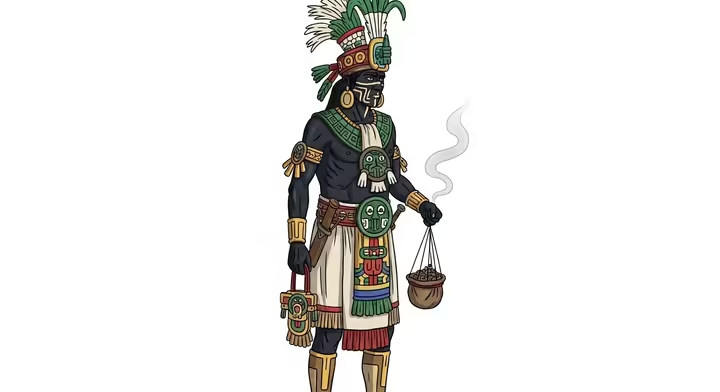
A key feature of Aztec religion was deity impersonation. During ceremonies, a chosen priest would be dressed in the full costume of a specific god, becoming an *ixiptla*. In this state, the individual was considered a living vessel for that divine being, a temporary manifestation of the god on earth.
The specialized attire of both warriors and priests was a technology of transformation. The wearer of a jaguar *tlahuiztli* or the regalia of a god was believed to become that entity. The costume was a medium for channeling power, ferocity, and identity.
| Number of Captives | Title/Rank | Awarded Garments | Awarded Insignia/Adornments |
|---|---|---|---|
| 1 | Tlamani | Tiyahcauhtlatlquitl (mantle with flower design) | Plain macuahuitl and chimalli |
| 2 | Cuextecatl | Red and black tlahuiztli | Conical cap ( copilli ); right to wear sandals |
| 3 | Tiachcauh | Ehecailacacozcatl ("wind-twisted jewel mantle") | Butterfly-shaped back device ( tlepapalotlahuiztli ) |
| 4 | Tequihua | Ocelototec (Jaguar-style tlahuiztli ) | Jaguar helmet; special veteran hairstyle |
| 6+ | Cuachicqueh ("Shorn One") | Yellow tlahuiztli | Distinctive shaved hairstyle with one braid |
Textiles as Tribute: Fueling the Empire
Textiles were the economic heart of the Aztec Empire. Woven goods acted as a primary form of money, the most demanded type of tribute, and a measure of a household's productivity. The imperial economy relied on textile production, a craft largely in the hands of women.
Weaving Imperial Wealth: Women's Role in the Textile Economy
In Mesoamerica, textile making was almost entirely women's work. This labor was the foundation of the household economy. Women wove to clothe their families, to create a surplus for sale or trade, and to meet the state's demands for tribute.
The economic importance of textiles is clearest in their role as a form of money. Certain types of cloaks, called *quachtli*, were used like currency. Debts, fines, and major purchases could all be settled with bundles of these cloaks.
The Empire's Demand: Insights from Tribute Codices
The tribute sections of the *Codex Mendoza* are like the empire's accounting books. They provide a detailed record of wealth taken by the Aztecs from conquered provinces. These lists clearly show that textiles were, by far, the most common and largest category of tribute demanded.
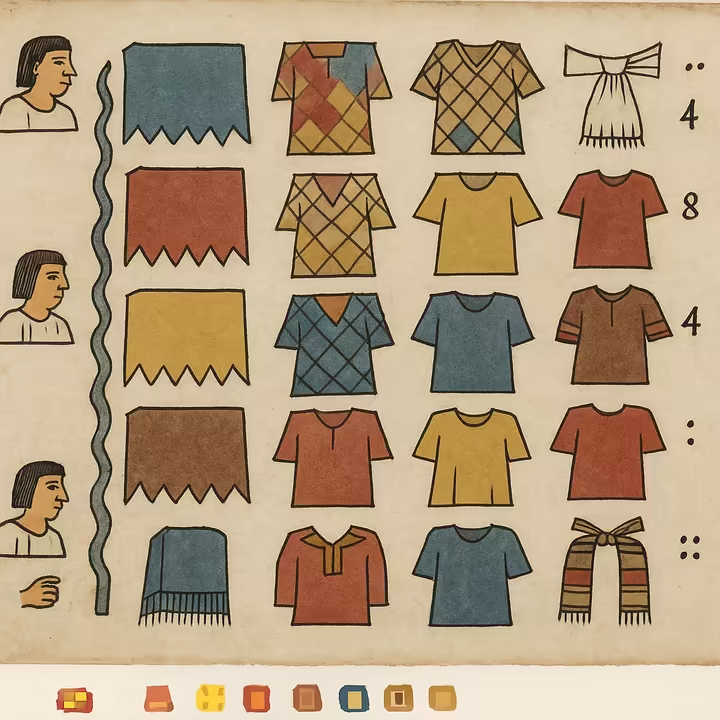
The scale was enormous. For example, the province of Tochtepec had to deliver 1,600 richly decorated cloaks, 800 striped cloaks, and 400 sets of women's skirts and blouses every six months. The empire's entire project depended on this constant, massive influx of woven wealth.
| Tributary Province | Semi-Annual Textile Tribute (Type & Quantity) | Other Key Tribute Goods |
|---|---|---|
| Tochtepec | 1,600 decorated mantas, 800 striped mantas, 400 women's tunics/skirts | Quetzal feathers, cacao, rubber, gold items |
| Coayxtlahuacan | 1,200 loads of mantas (3 styles), 400 loincloths, 400 women's tunics/skirts | Greenstones, feathers, cochineal, gold dust |
| Tuchpa | 800 loads of rich mantas, 800 loads of white mantas with colored borders | Chili peppers, cotton |
| Cuetlaxtlan | 800 loads of large white mantas, 400 loads of decorated mantas | Quetzal feathers, greenstones, turquoise |
| Ocuilan | 400 loads of maguey-fiber mantas | Maize, beans, chia, amaranth |
| Xoconochco | 800 loads of decorated mantas, 400 loads of women's clothing | Cacao, jaguar skins, amber, feathers |
Colonial Shifts: Unraveling and Reweaving Traditions
The Spanish conquest in 1521 deeply disrupted and changed the Mexica clothing system. The complex web of meaning, law, and economy woven into Mexica dress was torn apart and re-woven into a new colonial fabric.
New Styles, New Rules: How Conquest Changed Indigenous Dress
The Spanish brought new materials, technologies, and clothing norms. They introduced sheep, and with them, wool. They also brought silk and the large, stationary treadle loom, which began to shift textile production away from being solely women's work.
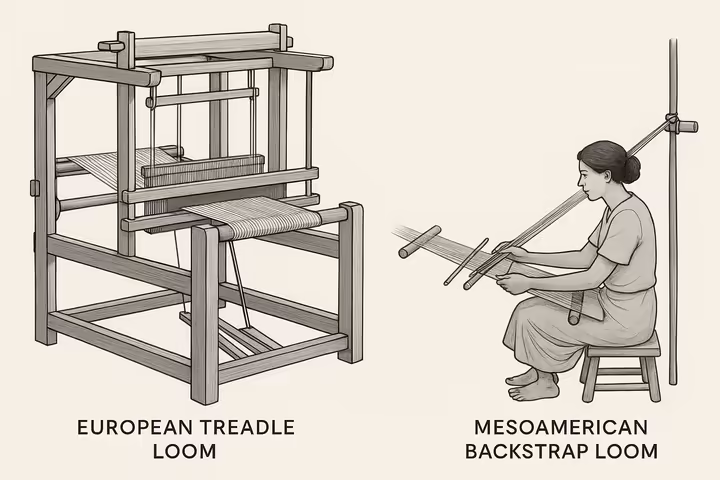
Indigenous dress started to incorporate European elements, leading to new, mixed styles. The Spanish *blusa* (blouse) began to be adopted, and new garments like the *rebozo* (shawl) emerged.
Crucially, the Spanish dismantled the Aztec dress code and imposed their own laws. These new rules were based not on class and achievement, but on the new colonial logic of race and caste. Laws were passed prohibiting indigenous peoples from wearing luxurious European fabrics like silk or using symbols of Spanish power, like swords and horses.
Whispers from the Past: Archaeological Textile Discoveries
Because of the humid climate, pre-Hispanic textiles rarely survive. This makes the few textile fragments discovered at Tenochtitlan and Tlatelolco exceptionally valuable. Preserved by accidental charring, these finds provide our only direct physical evidence of Mexica weaving.
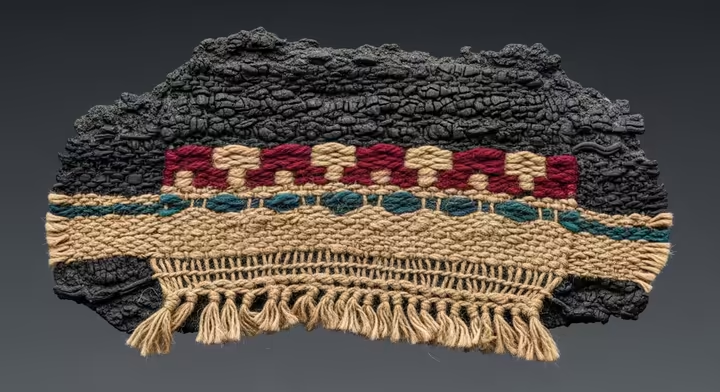
At Tlatelolco, an offering with a sacrificed child contained 42 charred textile fragments. Analysis revealed at least six different fabric types, bundled with a complete set of miniature female weaving tools.
At Tenochtitlan's Templo Mayor, a burial of an adult male dignitary yielded 96 charred cotton fragments. The fineness of the cotton and the intricacy of the weaves confirmed the high status of the buried individual.
Threads Through Time: Preserving the Legacy of Mexica Textiles
Despite conquest and competition from modern industry, threads of the ancient Mexica textile tradition have endured. The backstrap loom, the same technology used in the Aztec Empire, is still employed by indigenous weavers in many parts of Mexico today.
These contemporary artisans continue to produce cloth echoing ancient techniques and designs, a living link to their pre-Hispanic heritage. Garments with pre-conquest roots, like the *huipīlli*, have transcended their origins to become powerful symbols of Mexican national identity.
Nonetheless, this rich legacy is under threat. It faces pressure from the global market for cheaper, machine-made textiles that risk severing the final threads of this ancient and meaningful craft.